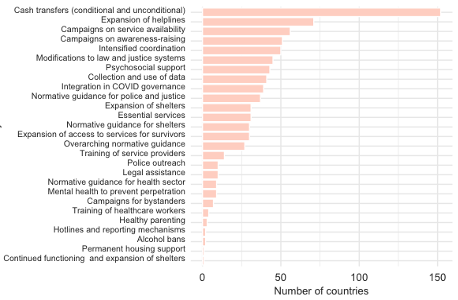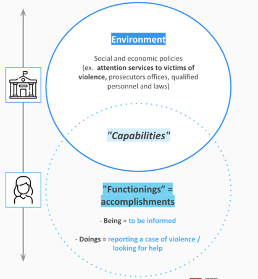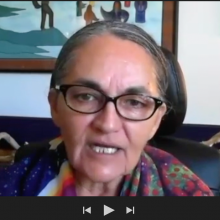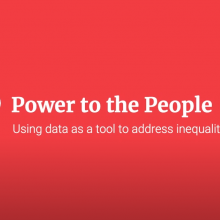Avanzando en el diálogo sobre la gobernanza de datos en América Latina y el Caribe
La gobernanza de datos habla de quién tiene autoridad y control sobre los datos y a la forma en que estos pueden ser utilizados, pero el término tiene diferentes significados y dista de ser claro en su aplicación. Como explicó un participante en la conversación inicial de una serie de diálogos regionales, "la cuestión es cómo integrar la democracia" en la gobernanza de los datos.
Las oficinas de estadística de América Latina y el Caribe (ALC) cada vez más se enfrentan a la necesidad de establecer marcos de gobernanza de datos en medio del rápido cambio tecnológico, las nuevas necesidades de información, aunado a una creciente preocupación en torno a la privacidad de los datos. Representantes de la región están buscando encontrar su lugar en el creciente ecosistema de demanda, producción y uso de datos.
Compartir conocimientos e ideas entre los proveedores y usuarios de datos es el primer paso para navegar por los cambiantes ecosistemas de datos y replantearse sus competencias, prácticas y responsabilidades. El fortalecimiento de la colaboración regional es fundamental para crear mayor claridad en torno a la gobernanza de los datos y abordar la complejidad y la urgencia de estas cuestiones.
En noviembre, líderes de las oficinas de estadística de Colombia y República Dominicana, organizaciones de la sociedad civil e instituciones de investigación intercambiaron perspectivas sobre la gobernanza de datos durante un evento paralelo de la Undécima Conferencia Estadística de las Américas. El debate puso de manifiesto algunos de los principales retos y recomendaciones que ayudarán a orientar las futuras conversaciones entre los líderes regionales.
Los institutos de estadística se enfrentan a leyes obsoletas, bajos niveles de confianza pública y recursos limitados.
Los marcos legales obsoletos y débiles obstaculizan la capacidad de las oficinas de estadísticas para avanzar en la gobernanza de los datos. A menudo, la legislación estadística se remonta a años atrás y está desfasada respecto a los últimos avances tecnológicos, así como a la emergente economía de los datos. Este tipo de leyes limita la capacidad de los institutos nacionales de estadística para estar a la vanguardia de la gobernanza de datos y coordinarse en todo el ecosistema de datos. En los casos en los que no es posible cambiar el marco jurídico a corto plazo, los institutos de estadística están tomando medidas para alinearse con las estrategias nacionales y hacer que la gobernanza de los datos ocupe un lugar más central dentro de estas estrategias.
Además, la falta de marcos jurídicos sólidos que promuevan eficazmente la independencia técnica de los institutos de estadística repercute en la percepción de confianza sobre las estadísticas oficiales. La ausencia de un mandato definido, de un ámbito de aplicación y de limitaciones para las oficinas estadísticas como administradores de los sistemas estadísticos nacionales ha dificultado la creación de confianza entre los nuevos usuarios y miembros del ecosistema de datos. Los participantes destacaron que la promoción de una cultura de la eficiencia y la innovación dentro de las oficinas estadísticas podría contribuir a reforzar la confianza en la institución.
Los participantes de las oficinas nacionales de estadística también explicaron que se enfrentan a un creciente desequilibrio entre las demandas y los recursos. Las capacidades y los recursos institucionales de las oficinas de estadística rara vez están a la altura de las crecientes expectativas y demandas de los nuevos productores y usuarios de datos , así como de la rápida evolución de los debates en torno a la gobernanza de los datos.
El camino a seguir
Los productores de datos deben asegurarse de que los datos representen los intereses de los sujetos de los datos, es decir, las personas que los proporcionan. "Nuestro papel es basar los marcos de gobernanza de datos en la realidad con un enfoque ascendente", explicó Julia Zulver, de Ladysmith.
Los participantes señalaron desarrollos y enfoques prometedores para los desafíos compartidos, acentuando la importancia de localizar las normas y los marcos, mejorar la transparencia y fomentar la colaboración. A continuación, se presentan las ideas principales que fueron el resultado del diálogo sostenido:
1. La privacidad de datos debe adaptarse a las necesidades locales y a los contextos políticos.
La preocupación sobre la privacidad cambia entre países y las expectativas de los individuos sobre el uso de sus datos por parte de los gobiernos son variables. Por ejemplo, en los países nórdicos las declaraciones de impuestos de todos los individuos son registros de acceso público, pero esto no es la norma en los países de AL&C. El contexto específico de la privacidad y las preferencias de los individuos hacia sus datos requieren de enfoques y soluciones a la medida.
Fabrizio Scrollini, Director Ejecutivo de La Iniciativa Latinoamericana por los Datos Abiertos (ILDA), destacó en el evento que se debe ir más allá de la consideración de la privacidad a nivel individual para reconocerla como una cuestión comunitaria y un fenómeno colectivo. Esto es especialmente importante cuando se consideran los grupos históricamente marginados y los riesgos potenciales de una mayor discriminación a través de las prácticas de datos.
2. Promover la transparencia y los sistemas de gobernanza de datos inclusivos genera confianza y credibilidad pública.
Patricio del Boca, desarrollador de software senior de la Open Knowledge Foundation, destacó que las oficinas estadísticas deben mejorar la transparencia de datos, metodologías y procesos para fomentar un mayor uso de los datos y fortalecer la confianza de los ciudadanos en la recolección, acceso y uso de información por parte de los gobiernos. Sin transparencia, tanto en los datos, como en los procesos de recolección y análisis de estos, explicó, puede generarse una falta de credibilidad derivando en una obstaculización en el aprovechamiento de los datos.
Las oficinas nacionales de estadística también pueden aumentar la confianza adoptando modelos de gobernanza de datos recíprocos, en lugar de extractivos. Los modelos recíprocos implican la recopilación de datos de diversas fuentes (públicas y privadas) a la vez que se devuelven a esas fuentes de datos. Este enfoque ha ayudado a la ONE de la República Dominicana a obtener acceso a datos meteorológicos y sobre el agua. A cambio, la ONE refuerza las competencias de los productores de datos, y les ayuda a reorganizar y actualizar sus procesos de recolección de datos y sus bases de datos.
3. La colaboración de múltiples actores interesados es fundamental para lograr la equidad y la inclusión a través de la gobernanza de los datos.
Al trabajar con mujeres en situaciones vulnerables, Julia Zulver, investigadora principal de Ladysmith, reconoció que la recolección de datos puede poner en peligro a las personas. Para proteger a los sujetos de datos, explicó que es importante evitar la recopilación de datos por el simple hecho de hacerlo. En su lugar, la recolección de datos debe tener una finalidad específica y estar vinculada a las preocupaciones y los cambios que las comunidades afectadas desean abordar. Este objetivo requiere que los investigadores co-diseñen programas y trabajen estrechamente con organizaciones de base para garantizar que los datos aborden las necesidades de las comunidades y se utilicen para amplificar las voces de las personas que son sujetos de datos.
Juan Daniel Oviedo, Director General del Departamento Administrativo Nacional de Estadística (DANE) de Colombia, explicó que el DANE tiene el mandato legal y constitucional de mejorar la visibilidad de las minorías en la producción estadística y ha trabajado estrechamente con los ministerios sectoriales para lograrlo. Esto requiere considerar no sólo la forma en que las oficinas de estadística responden a los nuevos mandatos, sino también la forma en que se involucran otros actores del sistema estadístico nacional.
El objetivo de la gobernanza de los datos debe responder a las necesidades específicas de las personas que están en el centro de los datos y proporcionar un marco para protegerlos y compartirlos para el bien público. Como explicó Patricio del Boca, de la Open Knowledge Foundation, trabajar conjuntamente para crear ecosistemas de datos y marcos de gobernanza ayuda a mejorar la calidad y el acceso a los datos para el bien público.
Mantener la colaboración regional
El diálogo, así como la cooperación regional e internacional, son fundamentales a medida que los institutos nacionales de estadística avanzan hacia un nuevo ámbito de configuración de los marcos de gobernanza de los datos, manteniendo al mismo tiempo la confidencialidad, la privacidad y la calidad de los datos.
En los próximos meses, el DANE y el GPSDD continuarán explorando la gobernanza de datos y temas relacionados con actores de toda ALC a través de una serie de actividades, incluyendo:
- La creación de oportunidades para el liderazgo, la consulta y la participación de AL&C en el Data Values Project, una campaña de consulta e incidencia de política que tiene como objetivo desbloquear el valor de los datos para todos.
- Reforzar las asociaciones entre ciudades, organizaciones locales y actores a nivel nacional para evaluar y replantear conjuntamente el modo en que la gobernanza de los datos puede permitir soluciones normativas.
- Profundizar en nuevos marcos, conceptos y experiencias a través de un nuevo grupo de trabajo sobre la administración de datos (data stewardship) en el marco de la Conferencia Estadística de las Américas - Comisión Económica de las Naciones Unidas para América Latina y el Caribe, y reforzar el intercambio de conocimientos con el Grupo de Trabajo sobre la Administración de Datos de las Naciones Unidas, bajo el co-liderazgo del DANE y de Statistics Poland.
- Fomentar los intercambios de conocimiento regionales y Sur-Sur sobre prácticas de datos inclusivas, interseccionales y participativas a través de la Carta de Datos Inclusivos (Inclusive Data Charter-IDC).
Deseamos colaborar con una amplia gama de organizaciones de toda la región y agradecemos las ideas y los comentarios. Póngase en contacto con nosotros en [email protected].
Camilo Mendez y Daniel Peñaranda del Departamento Administrativo Nacional de Estadística (DANE) de Colombia con Jenna Slotin y Fredy Rodriguez del Global Partnership contribuyeron a este blog.
Notas: El Departamento Administrativo Nacional de Estadística (DANE) de Colombia y la Global Partnership for Sustainable Development Data, han reunido a estadísticos, investigadores y activistas de toda América Latina y el Caribe para explorar las normas que deberían orientar la gobernanza de datos y el quehacer de las oficinas nacionales de estadística. Este diálogo regional se integrará en un proceso global de política e incidencia: el Data Values Project.





